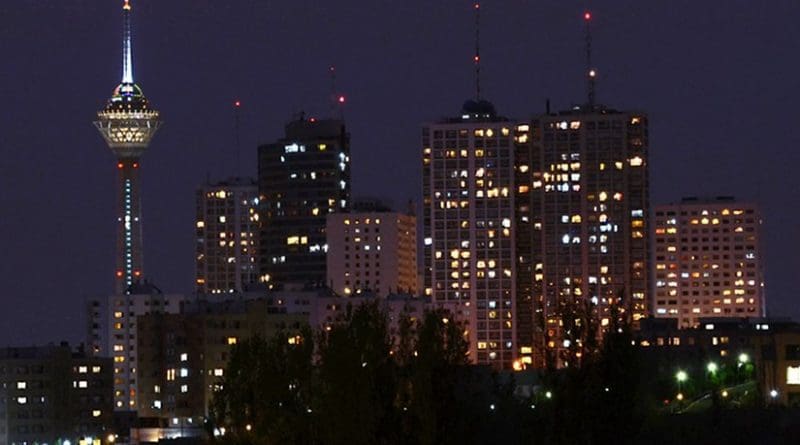Iran: Heavy Security Deployment In Tehran Amidst Protest Fears
By GVF
Security is said to be “tight” in the Iranian capital, amidst fears of a fresh wave of opposition protests on Ashura and national Students Day.
According to Green Voice of Freedom sources, on Tuesday anti-riot police in full armour gear and security forces on motorcycles were patrolling a number of neighbourhoods in central Tehran. In addition, helicopters circled in the central districts, keeping a close eye on developments on the ground.
A recently uploaded YouTube video shows a heavy security presence in Tehran on the holy day of Ashura. The clip appears to shows security forces positioned in important areas of city’s centre such as Haft-e-Tir Square, Enghelab Sq., Vali-Asr Sq., the intersection of Hafez and Enghelab Avenues as well as the intersection of Enghelab and Vali-Asr Avenues.
“The atmosphere [was] completely dominated by security [forces]. The non-stop hovering of helicopters, as well as patrols by the special guard and the police are reminiscent of the Ashura [protests in December 2009],” said another eyewitness who spoke on condition of anonymity.
“The intersection of Shademan and Sattarkhan, [was] filled with anti-riot forces and there [were] many police vehicles with cages. It was the same situation in Towhid Square,” he continued.
In December 2009, a wave of anti-regime demonstrations known as the “Ashura” protests swept Iranian cities. Clashes between Green Movement supporters and security forces during the protests left at least eleven protesters dead in Tehran, three of whom were run over reputedly by police cars. Among the slain protesters was Seyed Ali Mousavi, nephew of opposition leader Mir Hossein Mousavi, who was killed by an assassin’s bullet to the heart.
At least four other protesters were killed by security forces in the north-western city of Tabriz.
At the time, Tehran’s Deputy Police Chief Ahmad Reza Radan acknowledged the arrest of 300 individuals on state television, but shamelessly claimed that those killed included one person who fell off a bridge and two others who were killed in a car accident. Radan went on to add that only one protester had been killed by bullet. However, “considering the fact that the police did not use firearms, this incident is extremely suspicious, and is being investigated,” he said.
No one has been brought to justice for any of the crimes committed on that day.
Instead, many of those arrested during the Ashura protests, among them 65-year-old Malek Mohammadi, received lengthy jail terms while others are still awaiting trial. Three of the detainees were sentenced to death, however, in the end only Zahra Bahrami, an Iranian-Dutch national, was hanged in January 2011.
The Ashura protests were the last in a series of large-scale public demonstrations by Green Movement supporters in the 200 days that followed the rigged June 2009 presidential election. It wasn’t until 14 February 2011 that the movement’s leaders, Mir Hossein Mousavi and Mahdi Karrobi, called for new rallies in support of the Arab Spring. Shortly after the protests, the men were illegally placed under house arrest along with their wives.
In his recent scathing report on Iran’s human rights abuses, UN special rapporteur Ahmad Shaheed expressed concern over the absence of any formal charges against Mousavi and Karroubi as well as their loss of “control over their health care, access to publications, privacy and the ability to live a normal life.”
In an interview with the Nasim Online website, Saeid Saeidifar, head of public relations at Tehran Police, confirmed reports that security forces had been recently been deployed in the capital, but claimed that the forces had been there to “provide security” for Ashura mourners and not in anticipation of demonstrations on Ashura and Nation Student Day, 6 and 7 December respectively.
The massive police deployment is despite the fact that Iran’s major opposition groups, in particular the Coordination Council of the Green Path of Hope (an important Green Movement body), had not called for specific actions ahead of the two occasions.
Analysts say the large-scale presence of security personnel on the streets of the capital is yet another indicator that Iran’s ruling hardliners are still uneasy about the prospect of opposition protests erupting in the country, despite the regime’s numerous claims of having successfully quelled the pro-democracy Green Movement.
In anticipation of Student Day, in late November the Coordination Council for the Green Path of Hope called on students to take the “initiative” to express “dissatisfaction” over the current state of affairs in the country. In their statement, council members predicted that the upcoming parliamentary elections in March 2012 “will not be held freely.”
On 7 December (16 Azar in the Iranian calendar), Iran marks Student Day, an annual commemoration of the killing of three students at a protest on 7 December 1953, in the aftermath of an CIA-backed coup to restore the Shah to power and topple the country’s democratically elected Prime Minister Mohammad Mossadegh.
In a damning 21-page report submitted in September, the United Nations’ special rapporteur on the situation of human rights in Iran, Ahmed Shaheed, said that students in Iran “faced arrest and intimidation and were sometimes subjected to beatings and torture for their ties to legally registered student activist organisations.”
The UN report documented “physical and psychological abuse” against student activists who were regularly “coerced into making … televised confessions,” and were at times even “denied proper medical care” and the right to continue their higher education as a result of their political leanings.

